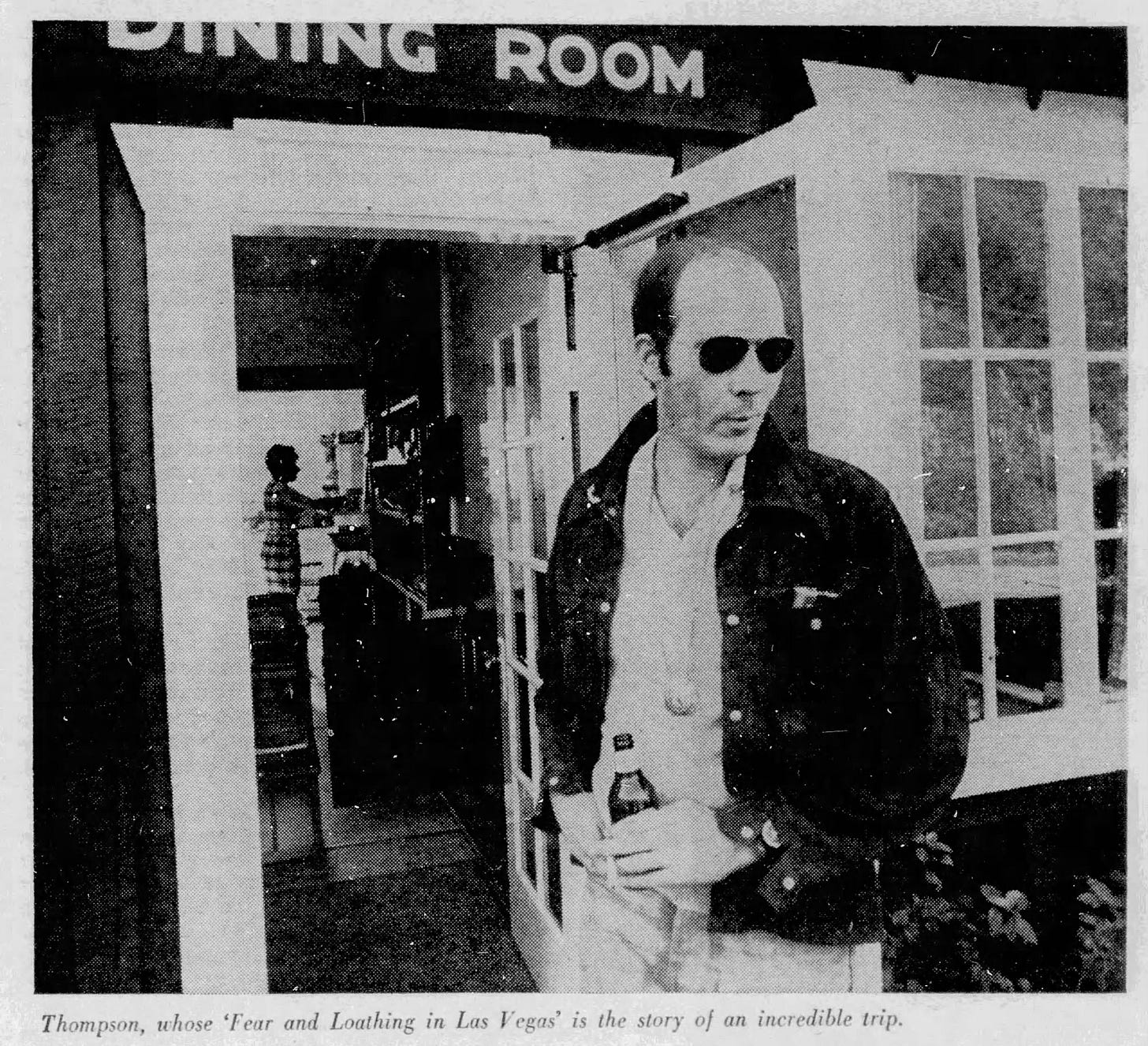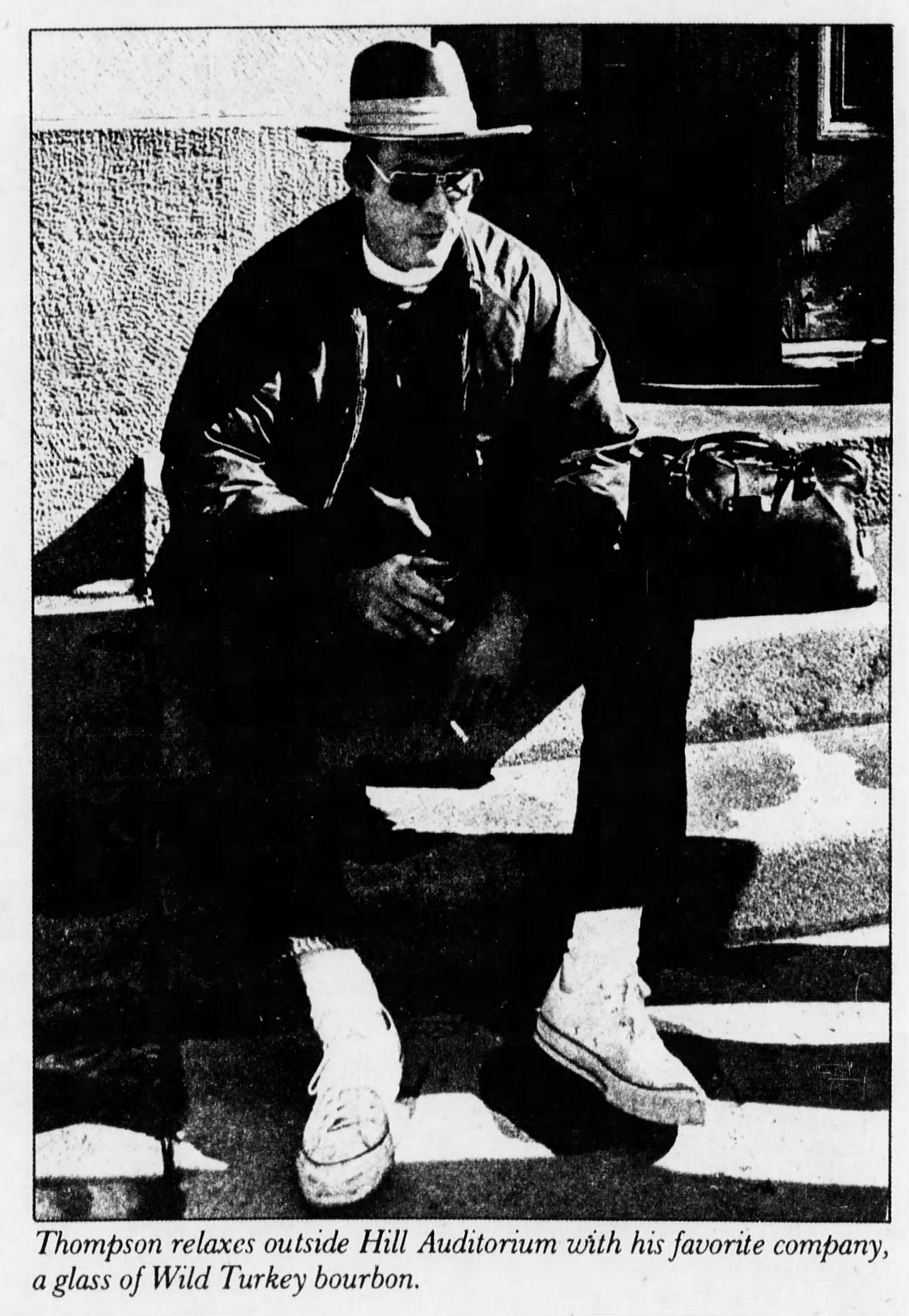The Squandered Legacy of Hunter S. Thompson
Why one of the greatest writers of the 1960s and 1970s remains so underappreciated.
Hunter S. Thompson died of a self-inflicted gunshot twenty years ago today and no doubt around the world a great many fans will raise glasses of Wild Turkey to his memory, perhaps lighting a joint or even dropping a little acid. While this may be a fitting tribute for a man who famously enjoyed these substances and more, perhaps it would be more appropriate to reflect on his literary accomplishments and to ask why he has received so little critical attention these past two decades.
If one looks at Thompson’s work from the sixties and early seventies, one sees the most gifted and hard-working writer of his generation. This was a man whose work was so stunningly original that it earned him his own literary genre: Gonzo. He specialised in chronicling the life of the outsider in that era of social upheaval, attempting to explain for “square” America the appeal of life as a biker or beatnik. He then turned his attention to the Death of the American Dream, which he saw in the failure of countercultural idealism and the election of Richard Nixon, before going on the campaign trail as Rolling Stone’s political correspondent.
No writer came close to covering that era with the clarity and humour of Thompson, and certainly not with his infectious vitriol. Yet his success came at a cost. Particularly in the late sixties and early seventies, he came to depend heavily on a number of substances. Of these, amphetamines allowed him to “tap latent natural energy resources,” he said. This meant he was essentially borrowing energy from himself at interest and he recognised that he would pay for it later. This was drastically worsened when he was given some cocaine by Rolling Stone magazine as part of an assignment in 1973. As various friends, family members, and colleagues have attested, coke put an end to Thompson’s capacity for good writing. For the remainder of his career—another forty years of struggle—he could barely put together two consecutive good sentences. His focus, his determination, and his creativity just dried up.
Thompson knew this and hated himself for it. He liked the adulation and very much enjoyed the young women keen to make the acquaintance of an infamous literary outlaw, but he yearned for the sort of respect his own heroes had earned—Hemingway, Conrad, Orwell, and above all Fitzgerald. He wanted to be in that pantheon of modern greats. He compared himself to these writers and sometimes spoke of himself among the finest writers of his own era—Kerouac, Ginsberg, Burroughs, Kesey, Wolfe.
Despite all the years of subpar writing, one cannot deny that at his best Hunter S. Thompson was one of the true greats. In a sense, all the fallow years can be forgiven when one considers the sheer brilliance of Hell’s Angels, Fear and Loathing in Las Vegas, and Fear and Loathing on the Campaign Trail ’72. There are many letters and articles too that are fantastically funny, insightful, and well written. Yes, he had his failures and unfortunately these were numerous and public, but almost any writer would gladly swap his entire oeuvre for the runaway success of what Thompson called “the Vegas book.” Few writers were able to capture an era the way Thompson did when covering the late sixties. I can’t think of a single other writer so original that he earned his own literary genre.
The sad truth, however, is that twenty years after Thompson’s death, and more than fifty years after the publication of his most famous work, the creator of Gonzo Journalism is not considered “a serious writer,” and there are various reasons for this. One is the sort of fan he attracted. As biographer William McKeen wrote in the excellent Outlaw Journalist, “Hunter had a legion of fans who had never read a word he had written,” and even today that seems to be true. Fans dress up as him for Halloween and get tributes tattooed on their arm, but most of them struggle to differentiate between the character played by Johnny Depp in the 1998 movie adaptation of Fear and Loathing in Las Vegas and the author who had written the book.
The writers I mentioned earlier, and especially the Beats, also struggled to be taken seriously when they were producing their most groundbreaking work, yet the Beats found a degree of academic acceptance long ago thanks to the hard work of pioneering scholars like Ann Charters, John Tytell, and Oliver Harris. In the Beat world, young fans turned into students and then professors, and they infiltrated the academy and brought Beat literature to university curricula. And it is not only in higher education institutions that writers gain real respect. Outside of these establishments, there are legions of serious fans who pore over their favourite writers’ work. But what of Thompson and his mostly illiterate fanbase? Where online Kerouac communities argue over interpretations of his novels and letters, Thompson communities are filled with cosplay and boasting about drug use. Burroughs message boards are occupied by discussions about rare books; Thompson ones are home to pictures of tabs of acid and tumblers of bourbon. They are also rife with conspiracy nuts spewing idiotic, paranoid fantasies and sharing their unreadable pseudo-Gonzo drivel.
The result is that in the academy, and other serious circles, Thompson is a guilty pleasure. He is someone you read but do not mention in public. It creates a sort of Catch-22 in which you cannot submit essays and books about Thompson because he is not respected enough and he is not respected enough because there are no essays and books about him. Again, academic editors and publishers are always going to be snooty and exclusionary but we need them to see beyond Thompson’s public image and the legions of frat-boy idiots with their Gonzo imitations make that unlikely. As long as Thompson is viewed as thoroughly in the domain of these brain-dead crackpots, he shall always be viewed as a drugged-up clown rather than the great writer that he was.
You may be reading this and thinking, “Well, who needs academic acceptance?” and “What’s wrong with just enjoying an author’s work for whatever reason?” Those are fair points but the counterargument is that a great writer should be respected for their work and Thompson simply isn’t. The chucklefucks who like his work simply see the catchphrases and shocking behaviour and laugh because it’s all they’re capable of understanding. Those who have the brainpower to look beyond that are embarrassed to be seen alongside the idiots. Moreover, Thompson wanted to be seen as a real writer. He wanted to be taken seriously. He hated that people couldn’t separate him from Raoul Duke.
Thompson was the greatest writer of the period 1965-1973 and that’s an incredibly important part of American history. It is important that we recognise his contributions and study his work. You may not care what goes on a university curriculum or gets dissected in a pretentious journal or added to the shelves of an exclusive library, but when the only people who read a writer’s work are stoned, drunk idiots who can’t see past the surface-level antics, that writer soon fades… He deserves better than that.
While many artists are only understood or taken seriously in death—with the aforementioned Kerouac being a great example—Thompson has not been even less lucky than that. Immediately after his suicide, it seemed we might be moving in the right direction. After a host of obituaries, there was an informative oral biography called Gonzo and a little later the wonderful biography Outlaw Journalist. But aside from those, only a handful of mostly quite limited studies have been issued. On the fiftieth anniversary of the publication of Fear and Loathing in Las Vegas, my own High White Notes: The Rise and Fall of Gonzo Journalism was released. It was the first serious inquiry into Thompson’s writing and I was told a great many times as I spoke with publishers that “Thompson is not a serious writer.”
The biggest problem, though, is the utter disinterest of the people tasked with managing his literary legacy. The estates of most great writers make efforts to ensure a continuing legacy. The Allen Ginsberg estate is the finest example, with a regularly updated website and staff eager to help scholars, filmmakers, and others interested in Ginsberg. The Kerouac estate has pushed the publication of many previously unpublished works and has encouraged scholars to write about him. As for Thompson, however, there has been almost nothing since his death. The long-promised third volume of his letters never materialized. There have been no collected versions of his early work. His archives are not available to researchers and no one at the estate is willing to answer questions from those writing academic studies. The best we got was a reissued version of an old book with a new introduction by the drummer from Metallica. The estate is more interested in selling Gonzo-branded gin and jewellery than helping his literary legacy.
There are a few fans who make efforts, some of whom have run websites that aim to preserve and share Thompson’s work, and one collector who regularly posts on social media recently donated a large archive to Indiana University, where for the first time researchers will have access to his unpublished work. This covers the period of his life when he was at his least productive, but it is still a huge step forward. One can only hope that the rest of it will find its way into a university archive so we can start to see serious studies of Gonzo Journalism.
It could still happen. Anniversaries have an odd way of conferring legitimacy. In the Beat world, we have seen many significant ones over the past decade or two, and each one brings new interest. I sincerely hope that today’s anniversary does not go unnoticed and that we begin to see some serious critical inquiries into the life and work of one of the 20th century’s most misunderstood and underappreciated artists.







I use Las Vegas in my Southwestern American Lit class— but Thomason’s work doesn’t get taught often enough….